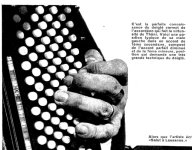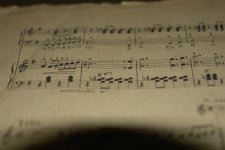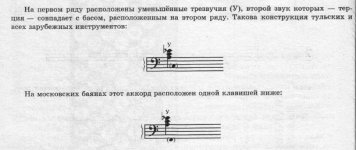When there are just three chord button rows (because there are just 5 rows in all, or 6 rows of which 3 are basses), it's often the case that the last row is labeled as a seventh row but is rootless instead of fifthless (namely the button "C7" has notes E-G-B♭ and can also serve as Gdim).
Now there are instruments with 4 chord rows that are not like c-cm-c7-cdim but c-cm-c7-gdim. This is typical for Russian CBAs with 6 button rows on the left side (I think that most non-converters have just 5 rows here).
Are there other traditions?
The reason I am asking is that my own instrument has this layout and I'd like to know whether that served a single-person request or a larger trend.
Here is an excerpt from an article about that person:

The text is somewhat pompous but still makes comparatively clear that this instrument has the shifted diminished row that is used for creating a minor sixth chord (I don't get the text, really).
Is this just a personal quirk (like the 2 baritone bass rows next to the bellows that Morino first built in the 1910s or 1920s for Thöni) or were there more instruments in Switzerland or elsewhere (in particular C system ones and/or piano accordion)?
If this is just a personal quirk, it would imply that the instrument I am playing was intended for personal use of Thöni and not "just" an hommage. On the other hand, my instrument has a C system free bass, and I have no evidence that Thöni ever diverged from the 2-row baritone bass layout (low notes at the bottom like with a bayan) that he first got Morino to build in the 1910s or 1920s.
So I'd be quite interested in news about other occurences of that shifted diminished row. It would make for a more complete picture.
Now there are instruments with 4 chord rows that are not like c-cm-c7-cdim but c-cm-c7-gdim. This is typical for Russian CBAs with 6 button rows on the left side (I think that most non-converters have just 5 rows here).
Are there other traditions?
The reason I am asking is that my own instrument has this layout and I'd like to know whether that served a single-person request or a larger trend.
Here is an excerpt from an article about that person:

The text is somewhat pompous but still makes comparatively clear that this instrument has the shifted diminished row that is used for creating a minor sixth chord (I don't get the text, really).
Is this just a personal quirk (like the 2 baritone bass rows next to the bellows that Morino first built in the 1910s or 1920s for Thöni) or were there more instruments in Switzerland or elsewhere (in particular C system ones and/or piano accordion)?
If this is just a personal quirk, it would imply that the instrument I am playing was intended for personal use of Thöni and not "just" an hommage. On the other hand, my instrument has a C system free bass, and I have no evidence that Thöni ever diverged from the 2-row baritone bass layout (low notes at the bottom like with a bayan) that he first got Morino to build in the 1910s or 1920s.
So I'd be quite interested in news about other occurences of that shifted diminished row. It would make for a more complete picture.
Last edited:


